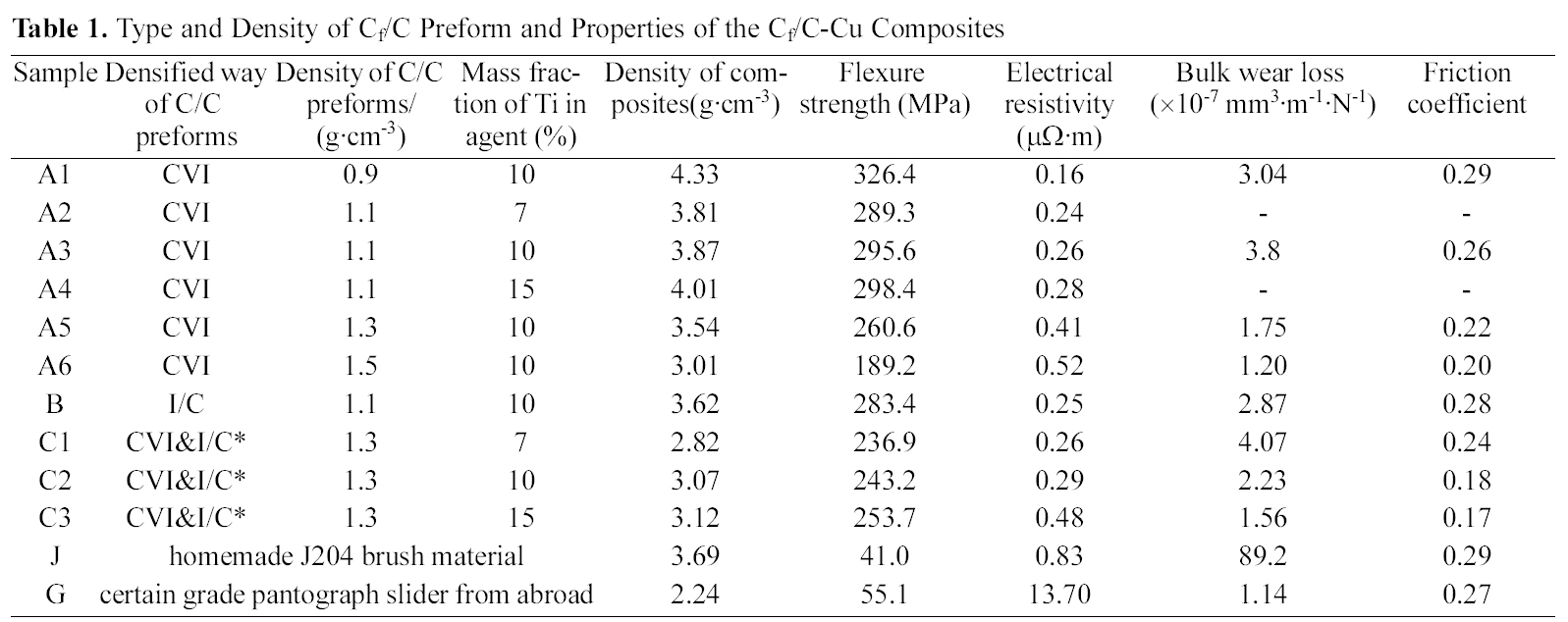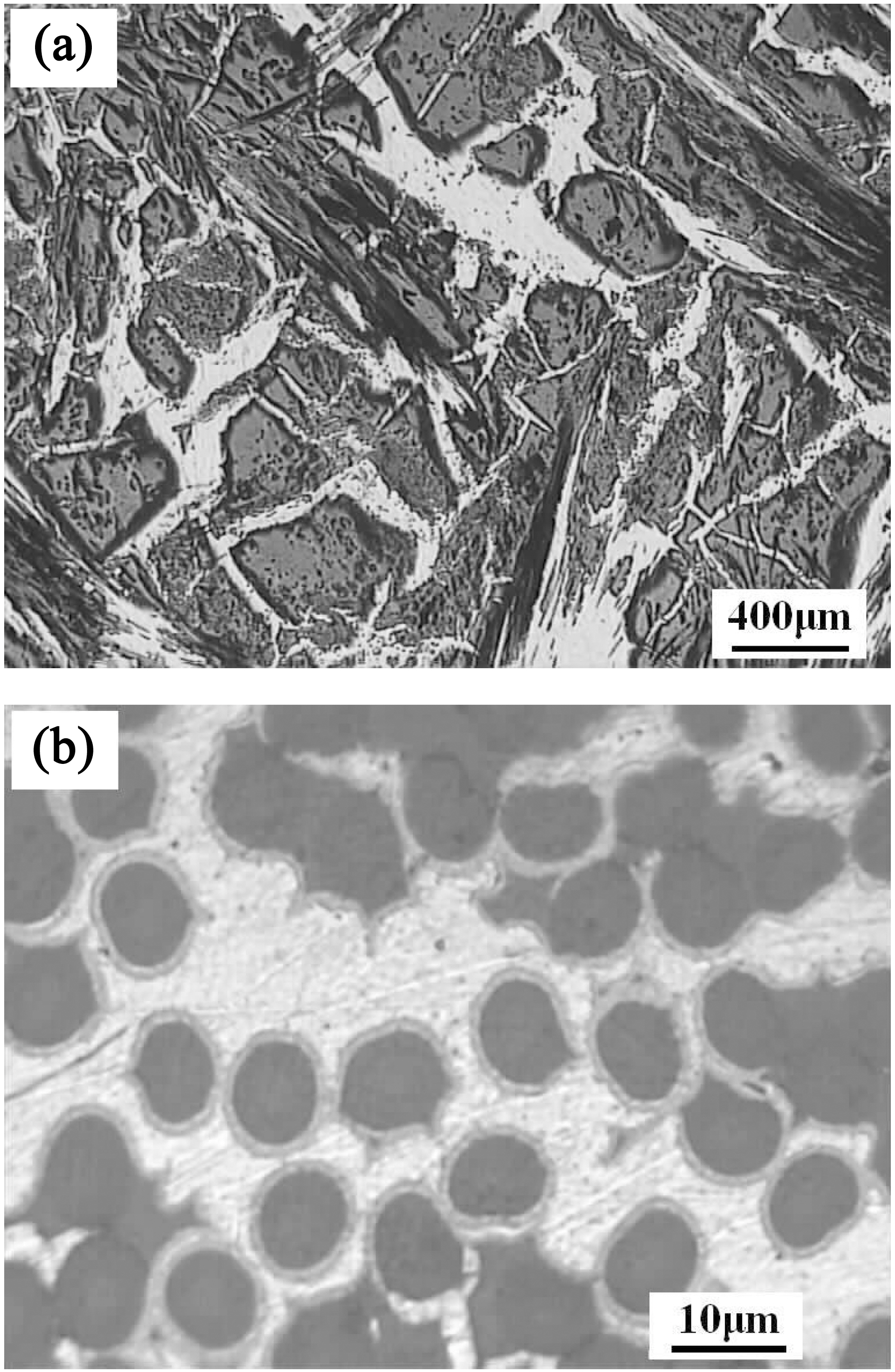


Sliding electric contact materials such as electrical brushes, pantograph sliders should possess good electrical conductivity and tribological property[1,2]. It is reported that C/C composite has high specific strength and modulus, high thermal and electrical conductivity and good self-lubricant property, and Cu-matrix composites possesses outstanding electrical and thermal conductivity. C/Cu (carbon/ copper) composites can combine the excellent properties of C/C and Cu, and meet the need of sliding electric contact material such as excellent electrical conductivity, good tribological property without lubrication[2,3]. In this paper, Cf/C-Cu composites were fabricated at first time by infiltrating molten Cu into porous Cf/C preforms with different density. In order to improve the wettability between C and molten Cu, Ti was added into infiltrating agent. The probability of using the Cf/C-Cu composite as materials for sliding electric contact has been explored by researching the microstructure and properties of the composites.
In this study, three kinds of porous Cf/C performs (Cf means carbon fiber, and C carbonized one after infiltration or impregnation) with different densities were prepared by using chemical vapor infiltration(CVI), resin impregnation and carbonization of furan resin(I/C), and CVI&I/C, respectively to densify the T300 PAN-fiber (poliacrylonitrile-baesd fiber) needle punched felt with the density of 0.55 g/cm3. The densitification process and density of porous Cf/C preforms were shown in table 1. Different mass fraction of Cu powder and Ti powder(with purity ≥ 99.5% and particle size 50 ㎛~75 ㎛) were mixed homogenously. The mixed powder and Cf/C preform were put in an alumina crucible,and then the crucible was placed into a vacuum furnace. The system was heated up to 1300℃ for an hour to ensured that Cu alloy was molten and infiltrated into Cf/C preforms by capillarity force. Finally, the Cf/C-Cu composites were obtained.
Phase analysis was conducted by X-ray diffraction (XRD). Microstructural characterization was carried out using optical microscopy (OM) and scanning election microscopy (SEM). Flexural strengths were determined by a three-point bending test. The electric resistivity of the composites was investigated by using dual-purpose Wheatstone bridge. Sliding wear and friction tests were performed under dry condition on block-on-ring apparatus with the composite specimens serving as the block. The experiments were operated under 50 N at a sliding velocity of 0.42 m/s for 10 h. The counterparts in the experiments were fabricated from red copper with Brinell hardness of 91.8 HBS. Meanwhile, test and compare the properties of sliding electrical contact materials of J204 and certain grade from abroad.
The XRD patterns (data not shown) show that the phases of the composite mainly consist of Cu, C and cubic TiC that formed by reaction of Ti and pyrolytic carbon in the preform.Fig. 1 shows the microstructure of Cf/C-Cu composite fabricated by infiltrating molten Cu into CVI preform. The bright phase is Cu which present network-like distribution and fill
[Table 1.] Type and Density of Cf/C Preform and Properties of the Cf/C-Cu Composites

Type and Density of Cf/C Preform and Properties of the Cf/C-Cu Composites
the pore of the composite. The gray phase is TiC which present lamina circularis distribution and circles around the Cf and pyrolytic carbon.
As seen in Table 1, the flexural strength of the Cf/C-Cu composite is far beyond sliding electrical contact materials of J204 and the abroad material, and the flexural strength of the Cf/C-Cu composite increase with the decrease of the preform density and increase of the volume fraction of Cu.Fig. 2 shows the fracture morphology of A1 sample. As seen in Fig. 2(a), there are lots of fiber pull-out at the point of fracture of the sample, and the dimple morphology of typical ductile fracture appeared in matrix of Cu. Thus the Cu of a continuous network structure and Cf preform have strengthened and toughened the composites.
The fabricating technique and density of Cf/C preform, the mass percentage of Ti in the infiltrating agent have a great effect on the electrical conductivity of the composites. For the same type of preform£¨the lower the density of the preform£¨the more the open pores, the better the electrical conductivity of the composites after infiltrating. The open porosity of I/C preform is lower than that of CVI preform with the similar density, resulting in the composite with lower relative density and higher electrical resistivity. With the increase of Ti in the infiltrating agent, the TiC content in the composites increase, and the electric resistivity of the composite increase. The continuous network of Cf and Cu ensure that the composites have good electrical conductivity, while the microstructure of Cu in traditional Cu/graphite electric brush material such as J204 is an isolated-like structure[4].
The friction and wear property is another important performance index of this material. From Table 1, the friction coefficient and wear rate of the composites decrease with the increase of the density of the preform. The friction coefficient of the composites made by CVI preform is lower than that of the composites made by I/C preform. There are lots of pyrolytic carbon in CVI preform and lots of resin carbon in I/C preform. In this research, the resin carbon has lower graphitization degree than that of pyrolytic carbon, and prone to being milled to be fine wear particle and
therefore spalling from the sample. The spalling particle has poor film forming ability, and hard to adhere to the surface of the coupled parts. All of these lead to the result that the bulk wear loss of B sample is lower than that of A3 sample. From Table 1, the friction and wear property of Cf/C-Cu composite is close to that of certain material from abroad, and better than that of homemade J204 material under the same conditions.
The Cf/C-Cu composite is a very competitive new sliding electric contract material fabricated by infiltrating molten Cu into Cf/C preform. Ti was added into the infiltrating agent to improve the wettability between Cu and C, and make Cu fill the pore of the preform and presents network-like distribution. The properties of the composites vary with the preparation method, density of the Cf/C preform and the content of alloying element in the infiltrating agent. The properties of the composite could be adjusted according different applied demand. The composites have excellent conductive properties with electrical resistivity between 0.16 ~ 0.52 μΩ·m, which is lower than that of powder metallurgical brush material. The friction and wear properties of the composites are closed to certain grade pantograph slider from abroad and better than that of J204.


